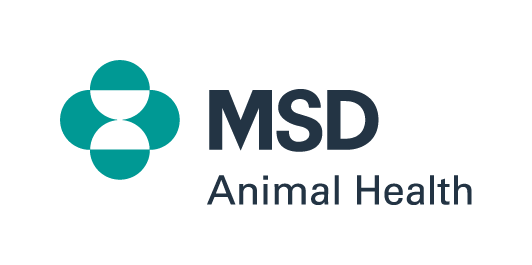Atrophic Rhinitis
A page about atrophic rhinitis in pigs describing cause, clinical signs, diagnosis and control.
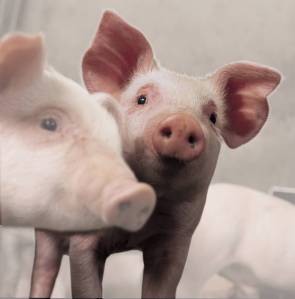
Information
Atrophic rhinitis is a contagious respiratory disease of pigs that is very common throughout the pig-producing world. Atrophic rhinitis is thought to reduce growth rates, which makes it an economically significant disease for pig producers. However, its financial importance has been variously estimated depending on whether a relationship was found between the presence of atrophic rhinitis and a negative impact on growth rate. Irrespective of this contention regarding its impact, it is very likely that in moderate to severe outbreaks, atrophic rhinitis can be of considerable economic importance.
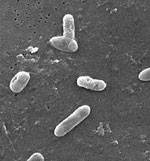
Aetiology
Bordetella bronchiseptica is best known as the predisposing causal agent in atrophic rhinitis. In order to cause atrophic rhinitis it colonises the nasal epithelium and secretes a cytotoxin, creating a favourable environment for the subsequent colonization of Pasteurella multocida. Only certain strains (those producing AR+ toxin) are capably of eliciting the exotoxin responsible for the damage to the nasal bones (turbinates) which leads to Atrophic Rhinitis. Despite the ability of B. bronchiseptica to produce turbinate atrophy in experimental infections, the disease did not progress beyond the mild-to-moderate category until AR+ P. multocida were present. Equally P. multocida on its own is poorly capable of adhering to the nasal mucosa. However, when B. bronchiseptica initially colonises, the damage caused facilitates attachment of the P. multocida.
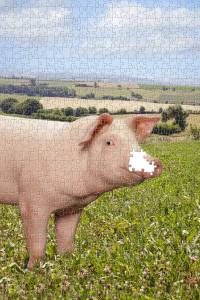
Epidemiology
Bordetella bronchiseptica causes disease in a wide range of host species, including dogs, cats (where it is one of the causes of cat ‘flu), pigs, rabbits and horses. B. bronchiseptica can infect other species commonly kept in contact with dogs and therefore inter-species transmission is possible in particular between dogs and cats. B.bronchiseptica can be shed for up to four months post infection. As stated earlier however, dermonecrotic toxin-producing strains of P. multocida are also required to produce disease in pigs. Increased severity is associated with overstocking and poor management, housing and environmental conditions. There is some disagreement regarding impact on production – As a general conclusion however, reduced productivity is associated with moderate to severe atrophic rhinitis, although the precise relationship between infection with these bacteria and negative impact on weight gains has not been thoroughly concluded. It has been noted that disease is more common in young herds and in herds where all-in-all-out farrowing practices are not possible / implemented.
Multi suckling increases the risk of spread of infection and environmental conditions including ventilation, presence of dust, gases or other nasal insults can increase severity of disease. The presence of other diseases such as PRRS and Mycoplasma can also elevate morbidity.
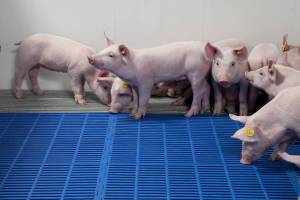
Clinical Signs
Clinical signs include twisting and shortening of the nose and upper jaw with associated wrinkling of the skin of the nose. Disease is often characterised by snuffling, sneezing (often haemorrhagic), and a oculonasal discharge. The discharge from the eyes is as a result of conjunctivitis or tear staining as the tear ducts become blocked by the snout distortion. As the animals breathing capability is affected, weight gain is reduced due to difficulty eating and reduced feed efficiency. There may also be an increase in respiratory disease / pneumonia due to the upper airway occlusion.
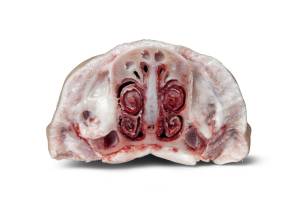
Diagnosis
Clinical signs of this disease are characteristic. The disease is also easily identified by post-mortem examinations of the nose where the snout can be examined in cross-section as in the photos (normal and abnormal respectively). Swabs from the nose can be used for identification of the causative agent. Blood samples may be taken for serology for some of the other common respiratory agents (Mycoplasma, PRRS).
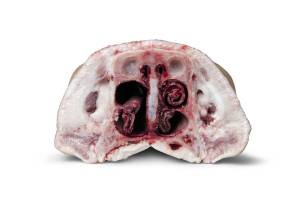
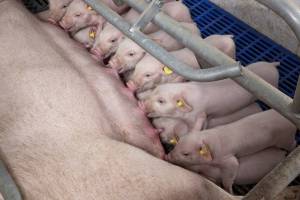
Control
Vaccination is obviously the best and easiest way to protect piglets against progressive atrophic rhinitis. The vaccine is administered to the sow in late pregnancy. It is important to ensure that a primary course of two doses is completed in adequate time prior to parturition and that piglets are observed carefully to ensure they receive adequate colostrum – especially where mismothering can happen with gilts / young sows. Further information on the only vaccine available for this disease may be obtained by clicking here. The vaccine may only be prescribed by your veterinary practitioner from whom advice must be sought.
Other preventative measures include adequate hygiene and ventilation, implementing an all-in-all-out policy in the farrowing house and avoiding mixing pigs from different litters.
Treatment of clinical cases – There is no successful treatment as damage to the skull structures in permanent and irreversible once it becomes clinically noticeable.
